Tetragnathinae
Dimitar Dimitrov and Gustavo Hormiga


This tree diagram shows the relationships between several groups of organisms.
The root of the current tree connects the organisms featured in this tree to their containing group and the rest of the Tree of Life. The basal branching point in the tree represents the ancestor of the other groups in the tree. This ancestor diversified over time into several descendent subgroups, which are represented as internal nodes and terminal taxa to the right.

You can click on the root to travel down the Tree of Life all the way to the root of all Life, and you can click on the names of descendent subgroups to travel up the Tree of Life all the way to individual species.
For more information on ToL tree formatting, please see Interpreting the Tree or Classification. To learn more about phylogenetic trees, please visit our Phylogenetic Biology pages.
close boxIntroduction
The subfamily Tetragnathinae includes the genera Tetragnatha, Pachygnatha, Glenognatha, Cyrtognatha and Dolichognatha. However, at least four other tetragnathid genera that have not been included in morphological phylogenetic analyses share some of the synapomorphies for Tetragnathinae and may belong here: Antillognatha, Doryonychus, Dyschiriognatha and Hispanognatha. Tetragnatha is the most species rich tetragnathid genus. Tetragnatha species are also known under the common name of “long jaw spiders” due to the markedly large and long chelicerae, especially in the males.
Characteristics
Probably the most remarkable anatomical feature of this subfamily is the simplification of the female reproductive organs. While all other tetragnathids have entelegyne genitalia, in tetragnathines the epigynum is missing and the fertilization ducts are lost. As a result there is a single duct connecting to the spermathecae, the copulatory duct, which during insemination transfers the sperm into the spermathecae. During fertilization the same duct is used to deliver the sperm to the eggs. Because tetragnathids are members of the Enlegynae Clade, tetragnathines are said to be secondarily haplogyne. Additionally, most of the genera in this subfamily develop membranous enlarged sections (sacs) of the uterus externus (Dimitrov et al., 2007). Another important feature of tetragnathines is the very close association of the embolus and the conductor of the male palp, which intimately coil together. The male palp also has a spherical and very large tegulum with an enlarged sperm reservoir and an articulated paracymbium.

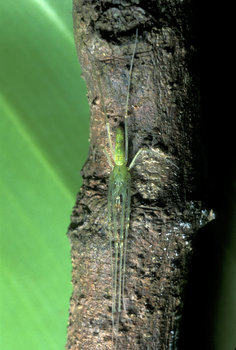
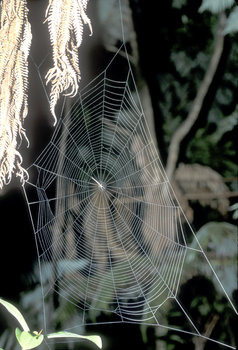
Left: Tetragnatha sp. from Hawaii. Right: Another Hawaiian Tetragnatha in its web. Images © Gustavo Hormiga
While most tetragnathines build orb-webs, some species (e.g., the members of the genus Pachygnatha or some Hawaiian species of Tetragnatha) have abandoned web building as a foraging strategy. Tetragnathine webs are two dimensional, usually horizontal, with an open hub and without retreat. In many species the webs are rather flimsy, with few radii and spiral turns.

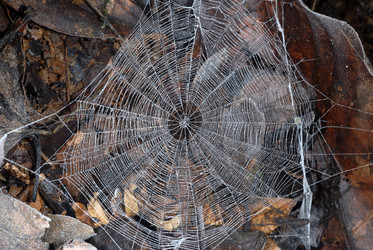
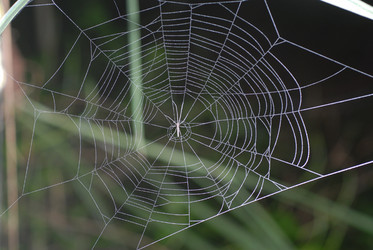
Left: Glenognatha species from Panama. Right: Australian Tetragnatha species. Images © Gustavo Hormiga
Discussion of Phylogenetic Relationships
Hormiga et al. (1995) provided the first phylogenetic study that included a large enough taxon sample to draw some conclusions on subfamilial relationships and on composition. They found a well supported Tetragnathinae lineage which included the genera Tetragnatha, Pachygnatha, Glenognatha and Dolichognatha. Recent studies (Álvarez-Padilla, 2007; Álvarez-Padilla et al., 2009; Dimitrov and Hormiga, 2009) have corroborated the limits of Tetragnathinae.
The genera Antillognatha, Doryonychus, Dyschiriognatha, and Hispanognatha have never been included in morphological analyses and are in need of taxonomic revision. However, they share some of the synapomorphies of this group and are provisionally listed here. Gillespie et al. (1994) included Doryonychus raptor (a species endemic to the island of Kauai and the only species in the genus) in a molecular phylogeny of Hawaiian Tetragnatha and demonstrated that this remarkable species is probably a relict member of an old radiation of Hawaiian Tetragnatha.
Phylogenetic relationships of Hawaiian Tetragnatha have been extensively studied by Gillespie and collaborators (e.g., Gillespie, 2004; Gillespie et al., 1994, 1997)
References
Álvarez-Padilla F., Dimitrov D., Giribet G., Hormiga G. 2009. Phylogenetic relationships of the spider family Tetragnathidae (Araneae, Araneoidea) based on morphological and DNA sequence data. Cladistics (In press).
Álvarez-Padilla F. 2007. Systematics of the spider genus Metabus O. P.-Cambridge, 1899 (Araneoidea: Tetragnathidae) with additions to the tetragnathid fauna of Chile and comments on the phylogeny of Tetragnathidae. Zool. J. Linn. Soc. 150: 285–335.
Dimitrov D., Hormiga G. 2009. Revision and cladistic analysis of the orbweaving spider genus Cyrtognatha Keyserling, 1881 (Araneae, Tetragnathidae). Bulletin of the American Museum of Natural History 317: 1-139.
Dimitrov D., Álvarez-Padilla F., Hormiga G. 2007. The female genitalic morphology of the orb weaving spider genus Agriognatha (Araneae, Tetragnathidae). Journal of Morphology 268: 758-770.
Gillespie, R.G. 2004. Community assembly through adaptive radiation in Hawaiian spiders. Science 303(5656): 356-359.
Gillespie, R.G., S.R. Palumbi and H.B. Croom. 1994. Multiple origins of a spider radiation in Hawaii. Proceedings of the National Academy of Sciences 91: 2290-2294.
Gillespie, R.G., H.B. Croom and G.L. Hasty. 1997. Phylogenetic relationships and adaptive shifts among major clades of Tetragnatha spiders (Araneae: Tetragnathidae) in Hawaii. Pacific Science 51: 380-394.
Hormiga G., Eberhard W.G., Coddington J.A. 1995. Web-construction behaviour in Australian Phonognatha and the phylogeny of nephiline and tetragnathid spiders (Araneae: Tetragnathidae). Aust. J. Zool. 43: 313–364.
Title Illustrations

| Scientific Name | Tetragnatha sp. |
|---|---|
| Location | South Africa |
| Specimen Condition | Live Specimen |
| Identified By | Gustavo Hormiga |
| Sex | Male |
| Life Cycle Stage | Adult |
| Image Use |
 This media file is licensed under the Creative Commons Attribution-NonCommercial License - Version 3.0. This media file is licensed under the Creative Commons Attribution-NonCommercial License - Version 3.0.
|
| Copyright |
© 2007 Gustavo Hormiga

|
| Scientific Name | Tetragnatha sp. |
|---|---|
| Location | Madagascar |
| Specimen Condition | Live Specimen |
| Identified By | Dimitar Dimitrov |
| Image Use |
 This media file is licensed under the Creative Commons Attribution-NonCommercial License - Version 3.0. This media file is licensed under the Creative Commons Attribution-NonCommercial License - Version 3.0.
|
| Copyright |
© 2009 Gustavo Hormiga

|
About This Page
Dimitar Dimitrov

Zoological Museum, University of Copenhagen
Gustavo Hormiga

George Washington University, Washington, D. C., USA
Correspondence regarding this page should be directed to Dimitar Dimitrov at
dimitard.gwu@gmail.com
and Gustavo Hormiga at
hormiga@gwu.edu
Page copyright © 2009 Dimitar Dimitrov and Gustavo Hormiga
 Page: Tree of Life
Tetragnathinae .
Authored by
Dimitar Dimitrov and Gustavo Hormiga.
The TEXT of this page is licensed under the
Creative Commons Attribution-NonCommercial License - Version 3.0. Note that images and other media
featured on this page are each governed by their own license, and they may or may not be available
for reuse. Click on an image or a media link to access the media data window, which provides the
relevant licensing information. For the general terms and conditions of ToL material reuse and
redistribution, please see the Tree of Life Copyright
Policies.
Page: Tree of Life
Tetragnathinae .
Authored by
Dimitar Dimitrov and Gustavo Hormiga.
The TEXT of this page is licensed under the
Creative Commons Attribution-NonCommercial License - Version 3.0. Note that images and other media
featured on this page are each governed by their own license, and they may or may not be available
for reuse. Click on an image or a media link to access the media data window, which provides the
relevant licensing information. For the general terms and conditions of ToL material reuse and
redistribution, please see the Tree of Life Copyright
Policies.
- First online 09 March 2009
- Content changed 09 March 2009
Citing this page:
Dimitrov, Dimitar and Gustavo Hormiga. 2009. Tetragnathinae . Version 09 March 2009 (under construction). http://tolweb.org/Tetragnathinae/134581/2009.03.09 in The Tree of Life Web Project, http://tolweb.org/




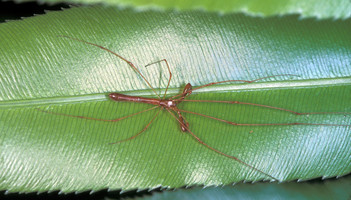
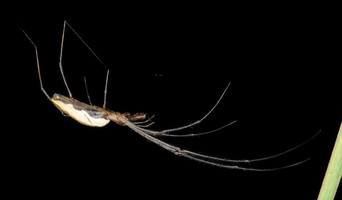
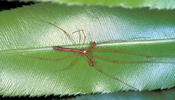
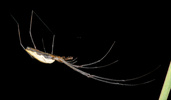

 Go to quick links
Go to quick search
Go to navigation for this section of the ToL site
Go to detailed links for the ToL site
Go to quick links
Go to quick search
Go to navigation for this section of the ToL site
Go to detailed links for the ToL site